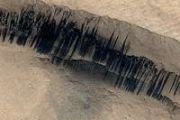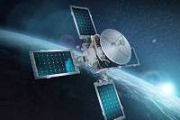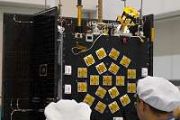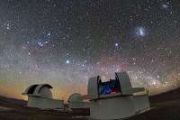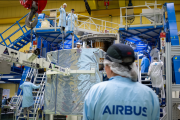
Copernical Team
Critical stress testing completed for Gateway Module
 NASA's Gateway space station has achieved a key milestone in its development. The Habitation and Logistics Outpost (HALO) module successfully completed static load testing in Turin, Italy, moving it closer to its final preparation for launch into lunar orbit.
This major hardware test marks an important step in Gateway's journey to the Moon, where it will serve both scientific missions and
NASA's Gateway space station has achieved a key milestone in its development. The Habitation and Logistics Outpost (HALO) module successfully completed static load testing in Turin, Italy, moving it closer to its final preparation for launch into lunar orbit.
This major hardware test marks an important step in Gateway's journey to the Moon, where it will serve both scientific missions and Nuclear rockets could travel to Mars in half the time
 NASA plans to send crewed missions to Mars over the next decade - but the 140 million-mile (225 million-kilometer) journey to the red planet could take several months to years round trip.
This relatively long transit time is a result of the use of traditional chemical rocket fuel. An alternative technology to the chemically propelled rockets the agency develops now is called nuclear therma
NASA plans to send crewed missions to Mars over the next decade - but the 140 million-mile (225 million-kilometer) journey to the red planet could take several months to years round trip.
This relatively long transit time is a result of the use of traditional chemical rocket fuel. An alternative technology to the chemically propelled rockets the agency develops now is called nuclear therma Space Command working with Office of Space Commerce for spaceflight safety
 US Space Force and the Department of Commerce, through the National Oceanic and Atmospheric Administration's (NOAA) Office of Space Commerce, have commenced a dual-track approach for delivering space situational awareness (SSA) services to satellite operators.
The two agencies are transitioning spaceflight safety services, currently offered through space-track.org, from US Space Command (U
US Space Force and the Department of Commerce, through the National Oceanic and Atmospheric Administration's (NOAA) Office of Space Commerce, have commenced a dual-track approach for delivering space situational awareness (SSA) services to satellite operators.
The two agencies are transitioning spaceflight safety services, currently offered through space-track.org, from US Space Command (U Antimatter glimpses may unlock mysteries of dark matter in the universe
 Unveiling the nature of dark matter remains one of cosmology's most pressing challenges. Though we know dark matter makes up more than 85% of the universe's matter, its true composition remains elusive. A recent study published in the 'Journal of Cosmology and Astroparticle Physics (JCAP)' explores antimatter traces in space that may point to a new class of particles, known as WIMPs (Weakly Inte
Unveiling the nature of dark matter remains one of cosmology's most pressing challenges. Though we know dark matter makes up more than 85% of the universe's matter, its true composition remains elusive. A recent study published in the 'Journal of Cosmology and Astroparticle Physics (JCAP)' explores antimatter traces in space that may point to a new class of particles, known as WIMPs (Weakly Inte ESA unveils new EO science strategy to tackle global challenges
 The European Space Agency (ESA) has launched its new Earth Observation Science Strategy, 'Earth Science in Action for Tomorrow's World', aimed at addressing escalating environmental challenges such as climate change, biodiversity loss, and extreme weather. The strategy, which looks forward to 2040, sets the course for leveraging satellite-based Earth monitoring to support policy and action towar
The European Space Agency (ESA) has launched its new Earth Observation Science Strategy, 'Earth Science in Action for Tomorrow's World', aimed at addressing escalating environmental challenges such as climate change, biodiversity loss, and extreme weather. The strategy, which looks forward to 2040, sets the course for leveraging satellite-based Earth monitoring to support policy and action towar Rutgers awarded $607,000 USDA grant to pioneer electroponics technology
 Rutgers Health has secured a $607,000 grant from the U.S. Department of Agriculture to spearhead the development of "electroponics," a new farming method designed to operate in water-scarce or zero-gravity environments, including space stations. This innovative approach aims to address the limitations of traditional hydroponics by leveraging precise agricultural techniques that minimize water us
Rutgers Health has secured a $607,000 grant from the U.S. Department of Agriculture to spearhead the development of "electroponics," a new farming method designed to operate in water-scarce or zero-gravity environments, including space stations. This innovative approach aims to address the limitations of traditional hydroponics by leveraging precise agricultural techniques that minimize water us Water production from thin air observed in real-time
 In a groundbreaking study, scientists at Northwestern University have, for the first time, witnessed hydrogen and oxygen atoms merging to form nano-sized water bubbles at the molecular level. This study aimed to unravel the mechanism behind how palladium, a rare metal, catalyzes this reaction, shedding light on new ways to accelerate water generation.
The team's work revealed that this pro
In a groundbreaking study, scientists at Northwestern University have, for the first time, witnessed hydrogen and oxygen atoms merging to form nano-sized water bubbles at the molecular level. This study aimed to unravel the mechanism behind how palladium, a rare metal, catalyzes this reaction, shedding light on new ways to accelerate water generation.
The team's work revealed that this pro No place too remote connecting the world from Pole to Pole via satellite
 Satellites are crucial for achieving global connectivity, especially in areas where traditional ground networks are unreachable. Through the Sunrise Partnership Project with Eutelsat OneWeb, supported by the UK Space Agency, ESA is extending advanced 5G connectivity across the globe.
The OneWeb constellation consists of over 600 satellites orbiting at 1200 km above Earth in low Earth orbit
Satellites are crucial for achieving global connectivity, especially in areas where traditional ground networks are unreachable. Through the Sunrise Partnership Project with Eutelsat OneWeb, supported by the UK Space Agency, ESA is extending advanced 5G connectivity across the globe.
The OneWeb constellation consists of over 600 satellites orbiting at 1200 km above Earth in low Earth orbit LEO satellites hold the key to resilient, interference-free navigation
 In Finland, frequent disruptions caused by GPS jamming have impacted daily civilian life, creating significant challenges for navigation. A new approach, utilizing Low Earth Orbit (LEO) satellites combined with massive Multiple Input Multiple Output (MIMO) antennas, offers a solution for these challenges. This method, which ensures accurate navigation even when traditional global navigation sate
In Finland, frequent disruptions caused by GPS jamming have impacted daily civilian life, creating significant challenges for navigation. A new approach, utilizing Low Earth Orbit (LEO) satellites combined with massive Multiple Input Multiple Output (MIMO) antennas, offers a solution for these challenges. This method, which ensures accurate navigation even when traditional global navigation sate ICEYE unveils Dwell Precise mode with enhanced 25 cm resolution
 ICEYE, a global leader in SAR satellite operations for Earth Observation, has launched Dwell Precise, a new imaging mode that delivers an impressive 25-centimeter resolution. This new capability builds on the earlier release of Dwell Fine in March 2024 and is based on ICEYE's 1200 MHz radar bandwidth, currently the maximum permitted for commercial satellites.
The Dwell Precise mode combine
ICEYE, a global leader in SAR satellite operations for Earth Observation, has launched Dwell Precise, a new imaging mode that delivers an impressive 25-centimeter resolution. This new capability builds on the earlier release of Dwell Fine in March 2024 and is based on ICEYE's 1200 MHz radar bandwidth, currently the maximum permitted for commercial satellites.
The Dwell Precise mode combine 














